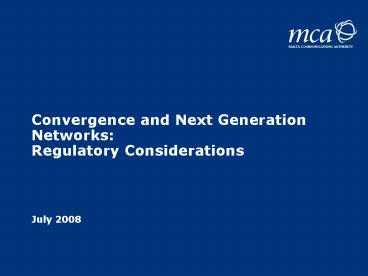Convergence and Next Generation Networks: Regulatory Considerations - PowerPoint PPT Presentation
1 / 10
Title:
Convergence and Next Generation Networks: Regulatory Considerations
Description:
Highlight regulatory challenges posed by Next Generation Access Networks ... Spurs introspective questions from regulator. 4. Role of regulator: ... – PowerPoint PPT presentation
Number of Views:74
Avg rating:3.0/5.0
Title: Convergence and Next Generation Networks: Regulatory Considerations
1
Convergence and Next Generation
NetworksRegulatory Considerations
July 2008
2
BROADBAND
Next Generation Access Networkmain catalyst
for future convergence
NGN
TV
TELEPHONY
- Purpose
- Highlight regulatory challenges posed by Next
Generation Access Networks - Lay down guiding principles
3
What is Next Generation Access?
Strict Definition Technology capable to deliver
a service beyond certain given quality thresholds
to home or office Ex. Broadband service in excess
of XX Mbps
Softer Definition Technology capable of
surpassing the best service levels offered by the
current technology
- Regulation is more concerned with
substitutability of services offered
Technological neutrality principle - Wired and Wireless technologies competing
4
Next Generation Access Role of Regulator
- Next Generation Access (NGA)is challenging
regulatory principles - Spurs introspective questions from regulator
- Role of regulator
- Main role to address permanent barriers/bottleneck
s to competition - Ensuring necessary conditions conducive to
efficient investment by market players - Asses the positive externalities of NGAs on
society
5
Next Generation Access Regulatory Challenges
Reconciling the need to foster conditions for
service-based competition with the need to invest
heavily in access technology
- Issues regarding complimentary infrastructure
such as ducts and trenches - Coexistance of multiple wired/wireless
technologies - Available alternatives in mode of fibre
deployment - Microtunelling, power lines, sewers etc.
- Technology neutrality for market definition EU
recommendation on access market
Important questions to determine whether FTTX is
a bottleneck for competition
6
Regulatory Approaches
Regulatory Holiday
Open Access
vs.
- Favouring investment
- US, Germany
- Can be time-specific or unlimited
- Advantages when there are prospects for
infrastructure competition
- Favouring service based competition
- UK
- Less incentive for investment
- Advantages in cases of one dominant
infrastructure
7
NGAs Regulatory Challenges
Role of Traditional Cost Orientation
- Current access infrastructure existed in a
relativity low risk environment - NGA investment entails business risk of untested
demand - Traditional cost orientation caps economic
benefits but exposure to risk is unbounded... - ...but lack of price control exposes
third-parties to risks of monopoly pricing - Should investment risk at the date of deployment
be factored in price control? - Commissioner Reding seems to favour this
compromise - How should this be quantified?
8
European Regulatory Framework
- Though this would need to adapt to Next
Generation Access, it has a solid base... - Mandatory consultative process - regulatory
certainty - Pan-European regulatory experience and expertise
- Transparency
- ...necessary building blocks for effective
regulation
9
Conclusions
Regulatory guiding principles
- Strive to address permanent bottlenecks for
competition - Not to distort efficient investment by over
regulating - Technological neutrality in market analysis
- Provide regulatory certainty
- Wide consultation and Transparency
10
Next Generation Access Networks MCAs way
forward
- The MCA is currently formulating a comprehensive
regulatory approach to Next Generation Access - Study and monitor international developments
- Participate and contribute in the formulation of
Commissions upcoming recommendation - Align its policy with this recommendation
- Intends to embark in a wide consultative process
with stakeholders - Is confident that it will find the right formula
to balance all these considerations































